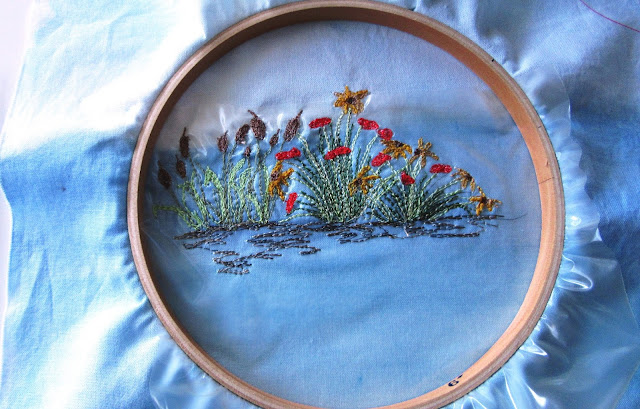Today I am working on an at home thread class project. It happens to be on thread painting. The technique uses water soluble medium called "Dissolve 4x Stabilizer" so that you can draw your design onto it, sew over it and dissolve the medium completely with water. The class was designed by Superior Threads with designer Nancy Prince. She is an award winning quilt artist from Florida. The threads used are 100% Trilobal Polyester fiber. Go here to see these threads and brands. The threads are shiny and they lay very flat. If you are going for this look, they're great. For this beginner thread class, they do work very well. The background fabric I used here is hand dyed cotton. The background, Dissolve medium and stabilizer are layered in a hoop and sewn over the lines drawn. Drop the feed dogs, loosen the tension and use a free motion embroidery foot to work your design. Change colored thread as needed for the top. The bobbin thread I used is a neutral color light weight polyester "Bottom Line" thread by Superior Threads.
This is just a small piece that will get cut down and sewn into a postcard. But, I am finding this technique a little awkward and probably will not use the soluble again.
Finished Post Card
I like variegated cotton threads in a couple different thicknesses that tend to give some dimension, depth and texture.
Couching down very thick threads, trims, yarns, and even metal threads add interest to designs. When I went on retreat 5 years ago in Cumbria, I briefly mentioned this class I took with designer Kate Dowty. This was an enjoyable liberating class and she was an exceptional teacher. See her "Pebble Splash" class example here. As soon as she described her inspiration for this piece, I knew I wanted to put my own view on it. The representation of pebbles, water, sand, and marsh is represented in movement across the three panels horizontally.
The elements are appliqued using fusible web and sewn onto wadding/batting backed panels and thread painted around each pebble, adding lines of quilting to show movement like water, waves, bubbles for texture, etc... then add the backing fabric to each panel and sew around close to the edges. I used several different fabrics for this from quilting cottons, to velvet and satin.
The backing is layered right sides together and sewn all around leaving the tops of each panel open. Make a few clips in the curves so they will turn easily, turn the pieces right side out. The tops can be finished simply by turning in the edges and whip stitched closed, however, I wanted some drama to the tops, so I made a stiff velvet cap for each panel. The beading is the final elements to be added to the design and some of the beads are sewn trailing off the edges. I am very happy with this piece and want to do a second design using a different colorway. ;o)











.jpg)
No comments:
Post a Comment